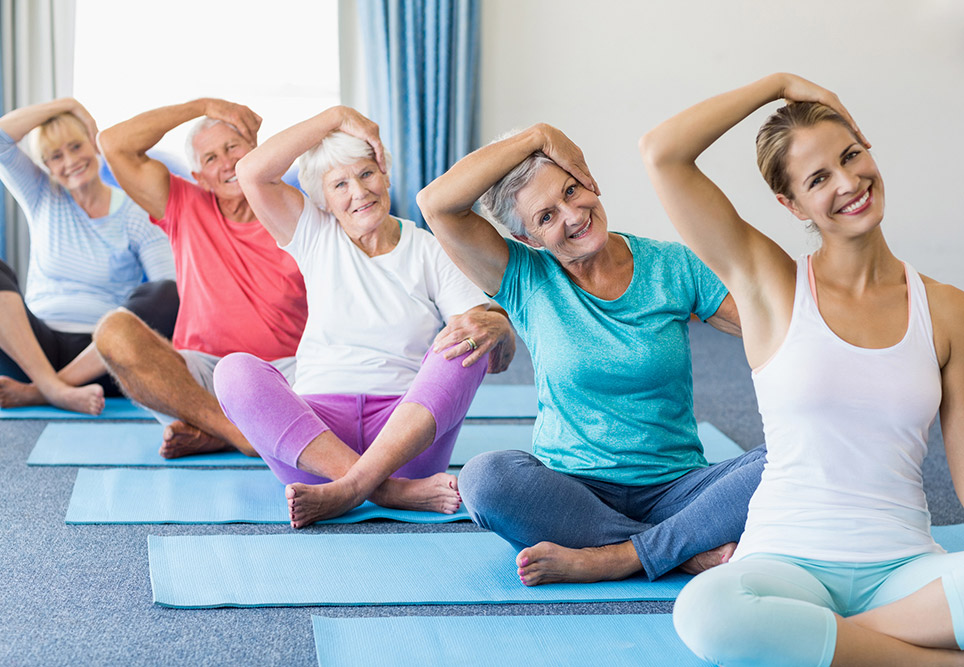 By Nicole Wetsman
By Nicole Wetsman
Participating in a yoga course decreased the number of falls reported by older adults in a rural community in Wisconsin, according to new research published in December.
Past research on yoga in elderly populations found that yoga increases strength and balance—both associated with reduced fall risk—but this is one of the first to draw a line directly between yoga and a decrease in the number of falls. The results appear in the journal Complementary Therapies in Medicine.
First author Irene Hamrick, MD, Professor of Family Medicine at the University of Wisconsin, and her collaborators enrolled 38 healthy adults older than 60 years in a free 8-week yoga course. Participants attended two 1-hour classes a week over the course of the study. Classes included seated and standing yoga poses, breathing exercises, body awareness, and meditation.
“We adapted the poses to their ability,” Hamrick said, “and advanced them as they were able to advance.”
During the 8 weeks, participants were also randomly assigned to either practice yoga for 10 minutes daily at home and do a 5-minute breathing exercise, or just perform the breathing exercise.
On surveys at the start of the study, 15 participants reported a total of 27 falls in the 6 months prior. In a follow-up telephone survey sixth months after the start of the study, respondents’ reports showed that, overall, the number had dropped significantly: During that time, 13 participants reported a total of only 14 falls. Participants also showed significant improvement on balance and strength tests between the start of the study and 1 week following the 8-week course.
There was equal improvement between the group that practiced yoga at home and the group that did not, which Hamrick said is an encouraging sign for future application of yoga programs.
“Many times, in real life, patients won’t continue the exercises,” Hamrick said. “But just going to the class was enough to stimulate the brain-to-muscle connection and reduce falls.”
Participants self-reported the falls measured in the study, which raises questions about accuracy, noted Kristine K. Miller, PT, PhD, Professor of Physical Therapy at Indiana University. Miller was not involved in the study. “Falls are really hard to track,” she said. “Sometimes people define a fall differently.” People also may not remember all of their falls, or may be reluctant to disclose them all, she noted.
However, the decreased number of falls came alongside improvements in strength and balance, which helps validate the reduction in the number of falls. The findings are congruent, and they support each other, Miller observed. Notably, she said, the average score on one of the physical assessment tests, the Dynamic Gait Index, jumped from 20 to 22; a score of 22 is the threshold indicating a low risk of fall.
This study was not able to identify the role that meditation and the breathing aspect of yoga played in fall reduction, although Hamrick said several study participants mentioned that they appreciated developing foot awareness as a part of balance during the yoga practice. Both she and Miller said that they hope to see more research work that teases out the role of mindfulness and breathing.
“It might help folks have a little bit motor control and balance because they’re relaxed,” said Miller.
Hamrick noted that this particular study was done in a small sample in a specific community and that more research in larger groups is needed to solidify the role that yoga might play in fall reduction in the elderly more generally.
Other balance and strength exercise programs, like tai chi, have been shown to decrease the number of falls, as noted by a meta-analysis the Journal of the American Geriatrics Society. Hamrick hopes future research will help build up a similarly robust base of evidence for yoga.
“We’re trying to expand the repertoire of available courses or activities that would be of value to our patients,” Hamrick concluded.
Sources:
Daubney ME, Culham EG. Lower-extremity muscle force and balance performance in adults aged 65 years and older. Phys Ther.1999;79(12):1177-1185.
Hamrick I, Mross P, Christopher N, Smith PD. Yoga’s effect on falls in rural, older adults. Complement Ther Med. 2017;35:57-63.
Lomas-Vega R, Obrero-Gaitán E, Molina-Ortega FJ, Del-Pino-Casado R. Tai chi for risk of falls. A meta-analysis. J Am Geriatr Soc. 2017;65(9):2037-2043.
Ni M, Mooney K, Richards L, et al. Comparative impacts of tai chi, balance training, and a specially-designed yoga program on balance in older fallers. Arch Phys Med Rehabil. 2014;95(9):1620-1628.







